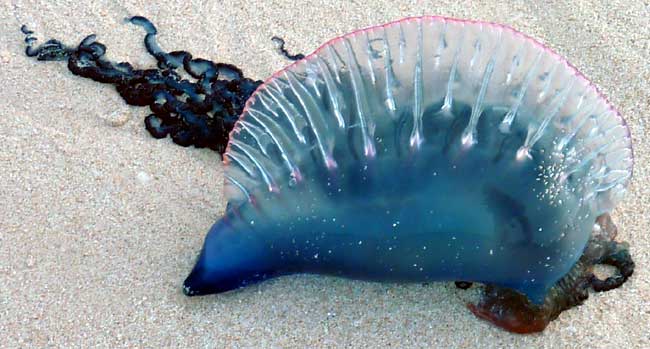
photo by Cotting White, on the Yucatan's northwestern coast

The beach could not have been more pleasant -- a warm, moist breeze off the water, white seagulls, terns and puffy clouds in the blue sky, and the water temperature just right. Deep in the beachcombing frame of mind I'd been walking for a mile or two, hardly ever looking up, absorbed in the variety of seashells and other washed-up flotsam and jetsam, when something new appeared at the water's edge:
It was a fairly transparent, blue bladder about two inches long and shaped like an overstuffed tamale. On the tamale's flat side ran a sort of seam with a mess of blue, soft-plastic-like, stringy affairs dangling from it. At first I thought it was a half-squashed balloon, but then I realized that with such a fishy odor it had to be an animal. Thanks to years of browsing pictures in National Geographic magazine a name for the thing gradually come to mind: Portuguese Man-of-war.
Back in Hotel Reef's computer room I confirmed it. It was a small one, for Portuguese Man-of-wars grow up to a foot long. Here we're talking about PHYSALIA PHYSALIS. Sometimes Portuguese Man-of-wars are known as Bluebottles. The animal mostly consists of an oblong bladder filled largely with nitrogen, floating atop the water. Below the bladder long, slender tentacles dangle catching food.
Farther up the beach a second specimen appeared (both dead). I dropped them into a plastic bag, brought them home in order to photograph them, but the next morning the bladders had collapsed into smelly mush.
In the picture above, those blue, stringy items attached to the "seam" along the flat side -- the bottom -- are the remains of tentacles. When the tentacles had been fresh they'd borne stinging "nematocysts" capable of paralyzing small fish and other prey, or raising painful whelps on the skin of swimmers. The tentacles on large Man- of-wars can dangle up to 165 feet below the water's surface. They are equipped with weak muscles enabling them to contract and drag prey such as stunned fish up to the Man-of-war main body floating at the water's surface.
As a kid Vladimir spent a lot of time on Bermuda, out in Physalia's main home area in the Atlantic, so I asked him what people there did for first aid when they got stung.
"They poured vinegar on the stings, or peed on them," he said. Sounds like Physalia nematocysts inject highly alkaline stuff.
Associated with the floating bladder are short, thick "digestive polyps" which secret enzymes into the prey, breaking it down into a simple, mushy state that can be absorbed into the Physalia body. Physalia eats not only small fish but also small crustaceans, algae and just about any other organic matter floating beneath it.
Amazingly, Portuguese Man-of-wars are not just one organism, even though they have their own scientific name and classification. Like lichens, whose bodies are composed of two distinct and unrelated species -- a fungus and an alga symbiotically living together -- the Portuguese Man-of-war is actually a COLONY of four different kinds of highly modified animal polyps. One polyp consists of the gas-filled bladder, another of the tentacles, one cares for eating and digestion, and the fourth for reproduction. Physalia are "dioecious," which means that they come in male and female editions.
Physalia's sexual cycle isn't completely understood, largely because it takes place far at sea wherever large numbers of the animal congregate. In our part of the world mating occurs in the fall, so that large numbers of young appear in the northern winter and spring. Thus my finding these small ones now makes perfect sense.
Man-of-wars larger than the ones I found bear a low crest serving as a sail. The organisms don't swim, but rather float wherever the wind blows them. Some individuals are bent so that they are blown 45 degrees to the right of the wind's direction, while others are bent to float 45 degrees to the left. This keeps large numbers from all being blown to the same place.
Though poorly illustrated, the University of Michigan's page on Physalia has well-organized information on the organism here.